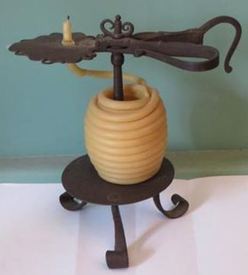 Take a spin through the database and you’ll soon realized there are so many little daily comforts that you take for granted. I don’t just mean things like heat and running water, but also things like adhesive envelopes. Sounds small, doesn’t it, in this age of online bill paying, but consider for a moment that Thomas Jefferson is estimated to have written more than 20,000 letters! That’s a lot of inconvenient sealing!
Take a spin through the database and you’ll soon realized there are so many little daily comforts that you take for granted. I don’t just mean things like heat and running water, but also things like adhesive envelopes. Sounds small, doesn’t it, in this age of online bill paying, but consider for a moment that Thomas Jefferson is estimated to have written more than 20,000 letters! That’s a lot of inconvenient sealing!
Movies make sealing letters look romantic and mysterious, but it was rather a hassle. You had to have heat to do it, which pretty much meant an open flame, and open flames weren’t necessarily that readily available. Candles were expensive, friction matches weren’t around yet, and thus an open flame meant finding a lit hearth somewhere nearby from which to light a heat source or fussing with a tinderbox. (And candle flames weren’t exactly ideal anyway – they burned too hot and most candles were tallow, so they smoked, so a candle flame could easily singe the wax and lead to a big blackened bubble that looked like the remnants of a scorched marshmallow – and then the wax might not form the desired seal.)
Enter the wax jack. They were developed around the mid-1600s, at least that seems to be when they began to gain wider use, and they were a simple design – a roller (a jack) on a frame or stand. Around them was wrapped the wax in the form of a long taper, normally a fiber wick coated to about the thickness of a modern ink pen with wax. (Beeswax was what used, as it did not smoke and was not as soft as tallow, which was soft enough to easily become a sticky, fused lump.) Held in place by a clip or scissors that also served the purpose of preventing the taper from burning dangerously low, the taper would burn with a tiny, bright flame perfectly suited for melting sealing wax.
They would go on to become so popular in the 1700s that they would become integral parts of desk sets and would as a result begin to vary more widely in form, style, and materials. They might be made of silver or brass, made with or without handles or snuffers, made with an array of designs used to feed out more of the taper.
Enclosed wax jacks, the same central concept of a spindle that fed out a taper only with the spindle enclosed in a container of some sort, usually egg- or tankard-shaped, and with the taper feeding out of a hole in the top, were called bougie boxes. Perhaps because the boxes allowed for a display of wealth and were more travel-friendly, they tended to be more widely used by the upper classes. In either case, based on age, materials, and form (versions with scissors are more valuable), wax jacks or bougie boxes can be quite collectible today, bringing anywhere from $50 to $1000 at auction.



